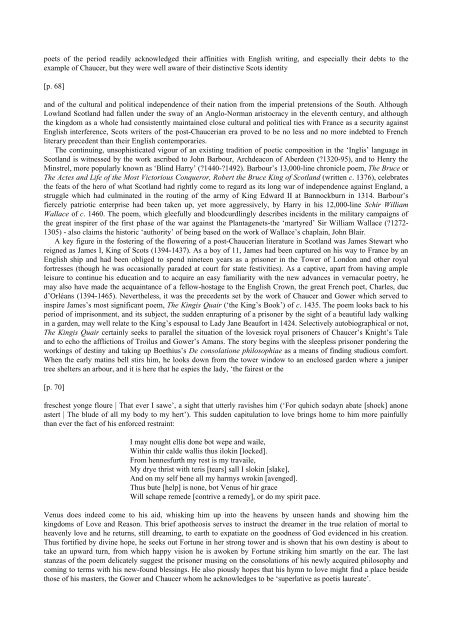THE SHORT OXFORD HISTORY OF ENGLISH LITERATURE
THE SHORT OXFORD HISTORY OF ENGLISH LITERATURE
THE SHORT OXFORD HISTORY OF ENGLISH LITERATURE
You also want an ePaper? Increase the reach of your titles
YUMPU automatically turns print PDFs into web optimized ePapers that Google loves.
poets of the period readily acknowledged their affinities with English writing, and especially their debts to the<br />
example of Chaucer, but they were well aware of their distinctive Scots identity<br />
[p. 68]<br />
and of the cultural and political independence of their nation from the imperial pretensions of the South. Although<br />
Lowland Scotland had fallen under the sway of an Anglo-Norman aristocracy in the eleventh century, and although<br />
the kingdom as a whole had consistently maintained close cultural and political ties with France as a security against<br />
English interference, Scots writers of the post-Chaucerian era proved to be no less and no more indebted to French<br />
literary precedent than their English contemporaries.<br />
The continuing, unsophisticated vigour of an existing tradition of poetic composition in the ‘Inglis’ language in<br />
Scotland is witnessed by the work ascribed to John Barbour, Archdeacon of Aberdeen (?1320-95), and to Henry the<br />
Minstrel, more popularly known as ‘Blind Harry’ (?1440-?1492). Barbour’s 13,000-line chronicle poem, The Bruce or<br />
The Actes and Life of the Most Victorious Conqueror, Robert the Bruce King of Scotland (written c. 1376), celebrates<br />
the feats of the hero of what Scotland had rightly come to regard as its long war of independence against England, a<br />
struggle which had culminated in the routing of the army of King Edward II at Bannockburn in 1314. Barbour’s<br />
fiercely patriotic enterprise had been taken up, yet more aggressively, by Harry in his 12,000-line Schir William<br />
Wallace of c. 1460. The poem, which gleefully and bloodcurdlingly describes incidents in the military campaigns of<br />
the great inspirer of the first phase of the war against the Plantagenets-the ‘martyred’ Sir William Wallace (?1272-<br />
1305) - also claims the historic ‘authority’ of being based on the work of Wallace’s chaplain, John Blair.<br />
A key figure in the fostering of the flowering of a post-Chaucerian literature in Scotland was James Stewart who<br />
reigned as James I, King of Scots (1394-1437). As a boy of 11, James had been captured on his way to France by an<br />
English ship and had been obliged to spend nineteen years as a prisoner in the Tower of London and other royal<br />
fortresses (though he was occasionally paraded at court for state festivities). As a captive, apart from having ample<br />
leisure to continue his education and to acquire an easy familiarity with the new advances in vernacular poetry, he<br />
may also have made the acquaintance of a fellow-hostage to the English Crown, the great French poet, Charles, duc<br />
d’Orléans (1394-1465). Nevertheless, it was the precedents set by the work of Chaucer and Gower which served to<br />
inspire James’s most significant poem, The Kingis Quair (‘the King’s Book’) of c. 1435. The poem looks back to his<br />
period of imprisonment, and its subject, the sudden enrapturing of a prisoner by the sight of a beautiful lady walking<br />
in a garden, may well relate to the King’s espousal to Lady Jane Beaufort in 1424. Selectively autobiographical or not,<br />
The Kingis Quair certainly seeks to parallel the situation of the lovesick royal prisoners of Chaucer’s Knight’s Tale<br />
and to echo the afflictions of Troilus and Gower’s Amans. The story begins with the sleepless prisoner pondering the<br />
workings of destiny and taking up Boethius’s De consolatione philosophiae as a means of finding studious comfort.<br />
When the early matins bell stirs him, he looks down from the tower window to an enclosed garden where a juniper<br />
tree shelters an arbour, and it is here that he espies the lady, ‘the fairest or the<br />
[p. 70]<br />
freschest yonge floure | That ever I sawe’, a sight that utterly ravishes him (‘For quhich sodayn abate [shock] anone<br />
astert | The blude of all my body to my hert’). This sudden capitulation to love brings home to him more painfully<br />
than ever the fact of his enforced restraint:<br />
I may nought ellis done bot wepe and waile,<br />
Within thir calde wallis thus ilokin [locked].<br />
From hennesfurth my rest is my travaile,<br />
My drye thrist with teris [tears] sall I slokin [slake],<br />
And on my self bene all my harmys wrokin [avenged].<br />
Thus bute [help] is none, bot Venus of hir grace<br />
Will schape remede [contrive a remedy], or do my spirit pace.<br />
Venus does indeed come to his aid, whisking him up into the heavens by unseen hands and showing him the<br />
kingdoms of Love and Reason. This brief apotheosis serves to instruct the dreamer in the true relation of mortal to<br />
heavenly love and he returns, still dreaming, to earth to expatiate on the goodness of God evidenced in his creation.<br />
Thus fortified by divine hope, he seeks out Fortune in her strong tower and is shown that his own destiny is about to<br />
take an upward turn, from which happy vision he is awoken by Fortune striking him smartly on the ear. The last<br />
stanzas of the poem delicately suggest the prisoner musing on the consolations of his newly acquired philosophy and<br />
coming to terms with his new-found blessings. He also piously hopes that his hymn to love might find a place beside<br />
those of his masters, the Gower and Chaucer whom he acknowledges to be ‘superlative as poetis laureate’.









